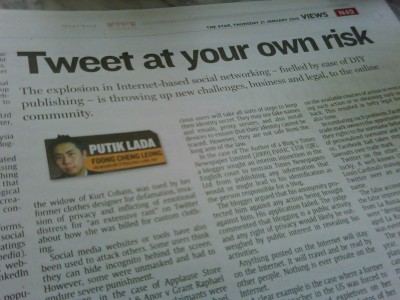Remember that I got my hands on the iPhone 4 from the Maxis iPhone 4 Launch? I finally got to test out its features.
So what’s new with it? What’s the difference with iPhone 3? The following are my observations.
Appearance
iPhone 4 appears sleeker than iPhone 3. It is flatter but heavier. It can get quite slippery sometimes due to the glass-like surface. Cool factor is of course there.
Retina Display
Retina display on iPhone 4 makes the screen clearer and more detailed. It’s like high definition TV. You can zoom out from a screen and still see the words clearly.
iOS4
iOS4 is the newest version of iPhone operating system. Although iPhone 3GS supports iOS4, I heard iPhone 3GS with iOS4 causes problems e.g it lags. It’s like trying to install Windows Vista on a Pentium I (ok, I may be exaggerating). With iOS4, the speed is good and multitasking is useful.
FaceTime
iPhone 4 has an additional camera on the front. It allows for “FaceTime” where a caller can look at the front camera and see the other caller.
The front camera however is slightly lower quality. Check out the comparison between a picture taken using a front facing camera and the back camera.
Front camera
Nevertheless, the front camera do take nice video. Like this one prepared by Jamie Toh.
Connection
The so-called Antennagate didn’t cause any problem for me. I think its over hyped by the media.
Since I got an iPad 3G, I subscribed to Maxis Broadband which provides for 3G connection using a Microsim. I used it on my iPhone 4 to go online.
The Maxis 3G connection is quite fast. I played a video on YouTube and it didn’t lag one bit. Check out the video below.
On the other hand, if you wish to subscribe to Maxis’ iPhone 4 plan, which plan you would require depends on our budget. For me, iValue 1 is most suitable for me. 1gig of bandwidth and 16GB iPhone are good enough for me. I just need to skimp on my data by turning on Wifi when I download large files. For more details on the plan, check out http://www.maxis.com.my/personal/iphone4/rates.asp
My only complaint about the iPhone 4 is the battery. It run out quite fast. But this is quite common among smartphones. To conserve battery, 3G, Wifi and cellular data should be turned off when not needed.
Applications
As many of you know, iPhone allows a user to download applications off the Apple store. Some are free and some must be purchased.
Facebook and Twitter are essential to me since I am hooked to the Internet. Facebook has its own App hence don’t bother searching for others. As for twitter, I downloaded Echofon as my Twitter App.
The problem with many free iPhone Twitter apps is that they are unable to retweet tweets. Echofon is one of them.
As for games, I downloaded the Millionaire Tycoon for my girlfriend. It only costs US$1. Additional map packs (extra maps) costs US$1 per piece.
Angry Bird, one of the world best selling app, is worth purchasing. I have the HD version on my iPad. 😀
Closing
Overall, iPhone 4 is a good phone. Many people asked me whether a Blackberry or an iPhone is good. To me, it’s like comparing apples and oranges. Blackberry to me is good for emails, chatting and work. But it’s terrible for surfing and games. Blackberry’s default browsers cannot load many websites. Maybank2u’s website is one example.
As for iPhone, it’s good for web surfing and games. It’s a little bit difficult for me to type but I guess I can get use to it. I did a typing contest with TimothyTiah once using a Blackberry and an iPhone. Our speed and accuracy were about the same.
So after downloading and installing all the essential apps, my iPhone 4 was perfect. Good things ought to be shared and hence, I gave it to my girlfriend 😀
Hope she will enjoy it as much as I do!
